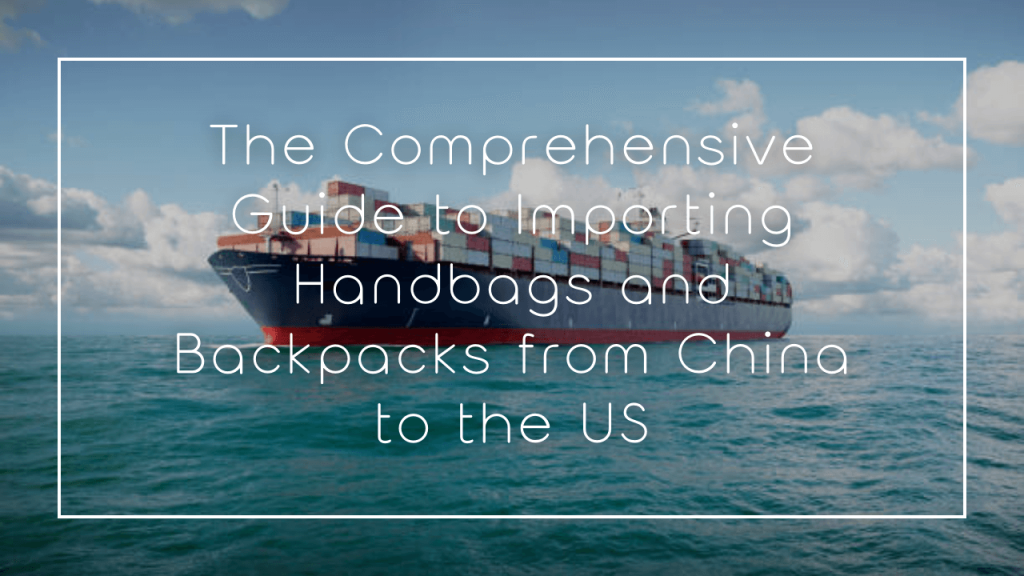
In an era of globalization, importing goods has become a lucrative measure to ensure your business stays competitive. Among the popular products in the trade industry are fashion accessories like handbags and backpacks, with China being one of the leading manufacturing hubs due to its cost-effective production processes. However, the pathway from selecting products in China to selling them on U.S. soil is interspersed with various stages that demand meticulous attention and comprehension of legal, logistical, and strategic frameworks.
This comprehensive guide aims to navigate entrepreneurs through the intricate process of importing handbags and backpacks from China to the United States, highlighting key steps, potential hurdles, and expert tips to ensure a smooth, profitable import operation.
1. Market Research: The Starting Point
Before you embark on the journey of international trade, understanding your home market is paramount. Is there a demand for the kind of handbags and backpacks you’re looking to import? Who are your competitors, and what are the prevalent price points? Conduct surveys, study market trends, and analyze consumer behavior pertaining to fashion accessories. This foundational step informs your business decisions and strategy and is continual, adapting as markets evolve.
2. Finding the Right Chinese Supplier: Your Make-or-Break Move
Your product’s quality hinges on the manufacturer, making this one of the most critical steps. Start by attending trade fairs, leveraging B2B platforms like Alibaba and Made-in-China, or hiring local sourcing agents. Request samples, ensure they adhere to quality standards, and establish clear, consistent communication to relay your requirements effectively. Remember, building a relationship with your supplier is as crucial as any contractual agreement.
3. Negotiations and Contracts: Setting the Ground Rules
Negotiating terms is not just about the cost; it’s about the entirety of the business deal. This includes payment methods, minimum order quantities, delivery schedules, and compliance standards. Incorporate all these into a formal contract, which should be explicit on quality expectations, timelines, and the implications of breaching agreements. An often-underestimated tool, a well-constructed contract is your first line of defense against future disputes.
4. Compliance and Standards: Navigating Legal Nuances
U.S. authorities are stringent about consumer product regulations, especially when it comes to items like handbags and backpacks. You’re required to meet standards set by organizations such as the Consumer Product Safety Commission (CPSC), ensuring your products are free from harmful materials and chemicals and comply with labeling requirements. Ignoring this step could not only lead to heavy fines but also irreparable brand damage.
5. Intellectual Property: Safeguarding Your Assets
In the realm of fashion accessories, designs are susceptible to copycats. Protect your unique designs and brand by understanding both U.S. and Chinese intellectual property laws. Register your trademarks and patents to safeguard your assets, an upfront investment that can save you from costly legal battles in the future.
6. Mastering Logistics: From China to Your Warehouse
Choosing between sea and air freight influences your cost and delivery time. While sea freight is more economical for bulky orders, air freight is faster and preferable for smaller, time-sensitive batches. Collaborate with a reliable freight forwarder, understanding your Incoterms, to avoid unexpected charges and delays. The logistics phase requires a strategic balance between cost-efficiency and time-sensitivity.
7. Customs Clearance: Your Entry Ticket
Customs can be daunting, involving a plethora of documents, from the Bill of Lading to the Commercial Invoice. Accurate Harmonized Tariff Schedule (HTS) codes are essential to ascertain the correct duty rates. Hiring a customs broker can be advantageous for those unfamiliar with the process, ensuring all paperwork is in impeccable order, preventing costly delays.
8. Tackling Trade Policies: Staying Ahead of the Curve
The economic landscape between China and the U.S. is ever-evolving, with politics playing a significant role in tariffs and import regulations. Staying abreast of current affairs and understanding how they can impact your import duties is vital to prevent your budget from spiraling out of control and to maintain legal compliance.
9. Risk Management: Expecting the Unexpected
From the moment your products leave the supplier, they’re subject to various risks. Secure comprehensive insurance to safeguard against logistical mishaps and consider third-party quality inspections for an unbiased assessment, ensuring your shipment is consistent with your standards.
10. Post-Arrival Strategies: Finalizing Your Game Plan
Upon your products’ safe arrival, it’s time to switch focus to distribution, storage, and marketing strategies. Your journey doesn’t end at customs clearance; instead, it evolves to include brand building, customer satisfaction, and market penetration.
Conclusion
Importing handbags and backpacks from China to the U.S. is more than a simple transaction. It’s a strategic chess game requiring foresight, adaptability, and extensive knowledge of various domains. Each step is a cog in a large machine, contributing to a seamless, efficient process. By understanding and meticulously following each phase, businesses can not only thrive but also build a resilient, reputable brand in a competitive marketplace. As you proceed, always keep a finger on the pulse of international trade policies, consumer trends, and your business’s innate needs. Herein lies the secret to transforming importing opportunities into booming success stories.